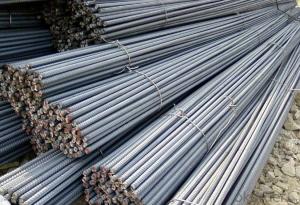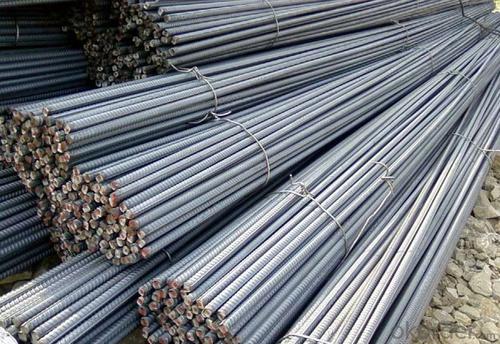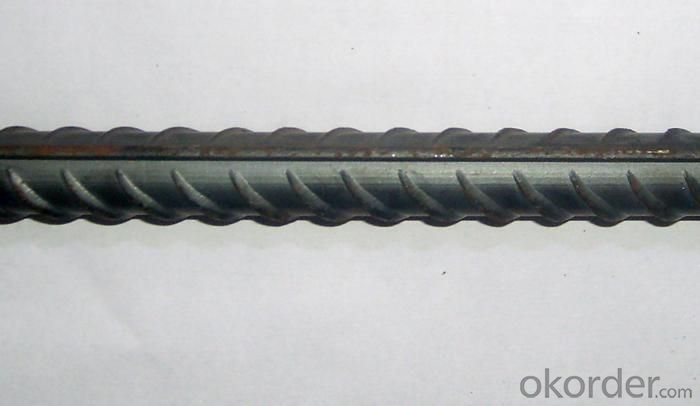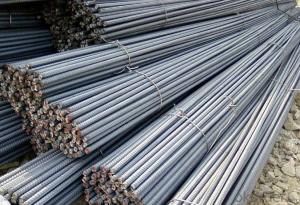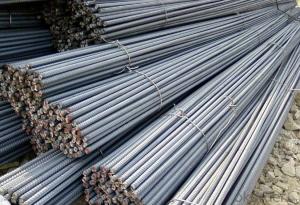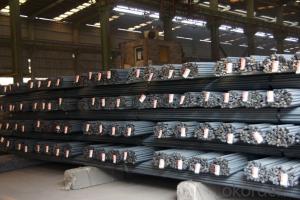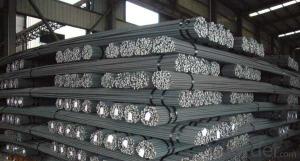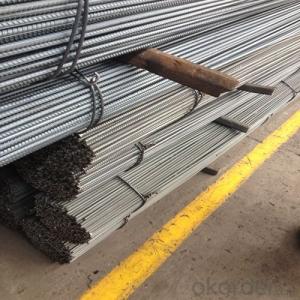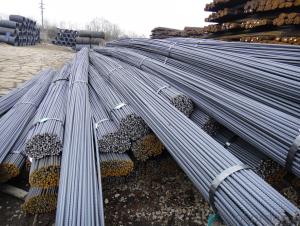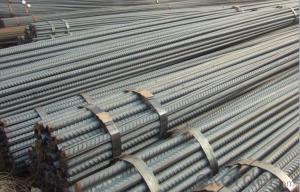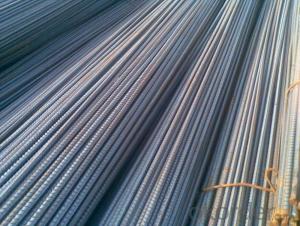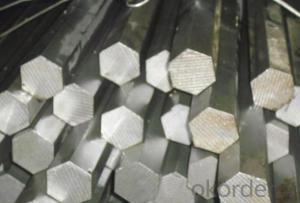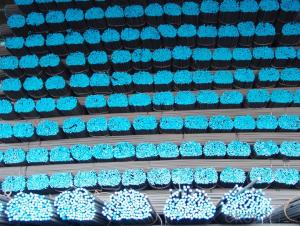Hot Rolled Carbon Steel Deformed Bar 28mm with High Quality
- Loading Port:
- China Main Port
- Payment Terms:
- TT or LC
- Min Order Qty:
- 25 m.t.
- Supply Capability:
- 30000 m.t./month
OKorder Service Pledge
OKorder Financial Service
You Might Also Like
Product Description:
OKorder is offering Hot Rolled Carbon Steel Deformed Bar 28mm with High Quality at great prices with worldwide shipping. Our supplier is a world-class manufacturer of steel, with our products utilized the world over. OKorder annually supplies products to European, North American and Asian markets. We provide quotations within 24 hours of receiving an inquiry and guarantee competitive prices.
Product Applications:
Hot Rolled Carbon Steel Deformed Bar 28mm with High Quality is widely used in buildings, bridges, roads and other engineering construction. Big to highways, railways, bridges, culverts, tunnels, public facilities such as flood control, dam, small to housing construction, beam, column, wall and the foundation of the plate, deformed bar is an integral structure material. With the development of world economy and the vigorous development of infrastructure construction, real estate, the demand for deformed bar will be larger and larger..
Product Advantages:
OKorder's Hot Rolled Carbon Steel Deformed Bar 28mm with High Quality are durable, strong.packed and suitable for construction
Main Product Features:
· Premium quality
· Prompt delivery & seaworthy packing (30 days after receiving deposit)
· Can be recycled and reused
· Mill test certification
· Professional Service
· Competitive pricing
Product Specifications:
Manufacture: Hot rolled
Grade: HRB335 HRB400 BS4449 Grade460 ASTM Grade40 Grade60
Certificates: ISO, SGS, BV, CIQ
Length:6m 8m 9m 12m
Packaging: Export packing, packed by coil
FAQ:
Q1: Why buy Materials & Equipment from OKorder.com?
A1: All products offered byOKorder.com are carefully selected from China's most reliable manufacturing enterprises. Through its ISO certifications, OKorder.com adheres to the highest standards and a commitment to supply chain safety and customer satisfaction.
Q2: How do we guarantee the quality of our products?
A2: We have established an advanced quality management system which conducts strict quality tests at every step, from raw materials to the final product. At the same time, we provide extensive follow-up service assurances as required.
Q3: How soon can we receive the product after purchase?
A3: Within three days of placing an order, we will begin production. The specific shipping date is dependent upon international and government factors, but is typically 7 to 10 workdays.
Q4: How many tons per bundle?
A4: Around 2-3tons
Q5: How to avoid the rust after deliver the goods to the loading port?
A5: We will keep the goods at the port covered with water-proof material
Q6: What is the chemical composition and physical properties of HRB400?
A6:
Grade | Technical data of the original chemical composition (%) | ||||||
C | Mn | Si | S | P | V | ||
HRB400 | ≤0.25 | ≤1.60 | ≤0.80 | ≤0.045 | ≤0.045 | 0.04-0.12 | |
Physical capability | |||||||
Yield Strength (N/cm²) | Tensile Strength (N/cm²) | Elongation (%) | |||||
≥400 | ≥570 | ≥14 | |||||
Q7:What is chemical composition and physical properties of 500B?
A7:
BS4449 500B | Chemical Composition(%) | ||||
C | Mn | Si | S | P | |
≤0.24 | ≤0.45 | ≤0.16 | ≤0.05 | ≤0.31 | |
Physical capability | |||||
Yield Strength(N/cm²) | Tensile Strength(N/cm²) | Elongation (%) | |||
≥650 | ≥500 | 19 | |||
Q8: What is the chemical composition and physical properties of HRB335?
A8:
HRB335 | Chemical Composition(%) | ||||
C | Mn | Si | S | P | |
≤0.25 | ≤1.60 | ≤0.80 | ≤0.045 | ≤0.045 | |
Physical capability | |||||
Yield Strength(N/cm²) | Tensile Strength(N/cm²) | Elongation (%) | |||
≥335 | ≥490 | ≥16 | |||
Images:
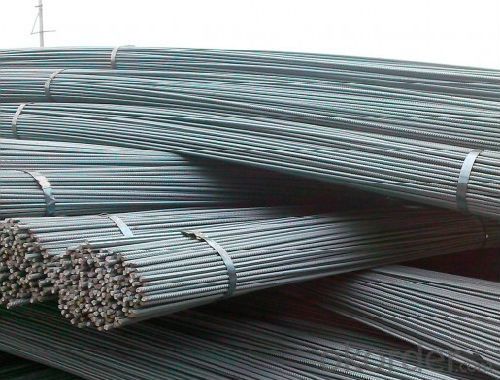
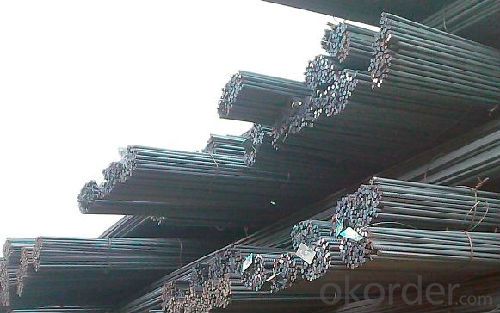
- Q: How are steel rebars protected during the concrete pouring process?
- To ensure the longevity and structural integrity of steel rebars during the concrete pouring process, several protective measures are implemented. Initially, prior to pouring the concrete, the rebars undergo meticulous cleaning to eliminate any rust, dirt, or contaminants that may compromise the bond between the rebar and the concrete. This is typically achieved by utilizing a wire brush or other mechanical methods. Once the rebars have been thoroughly cleaned, a common practice is to apply a protective layer or coating to them. An epoxy coating is frequently employed for this purpose. The coating acts as a barrier, preventing moisture and chemicals from reaching the steel and causing corrosion. Epoxy coatings are especially valuable in high-risk environments like marine structures or areas with a high chloride content. Another protective method involves the use of corrosion inhibitors. These inhibitors are added to the concrete mixture, which subsequently forms a protective layer around the rebars. By reducing the corrosive effects of chloride ions, oxygen, and other chemicals, the inhibitors work to prevent corrosion. Additionally, it is crucial to ensure adequate concrete cover over the rebars during the pouring process. Concrete cover refers to the thickness of the concrete layer between the surface and the rebar. Sufficient concrete cover safeguards the rebars against exposure to moisture, chemicals, and other environmental factors. To achieve the desired concrete cover, steel stirrups or spacers are positioned around the rebars to maintain a specific distance between the rebar and the formwork. This guarantees even distribution of the concrete around the rebars, providing them with the necessary protection. In conclusion, steel rebars are shielded during the concrete pouring process through various methods, including thorough cleaning, the application of protective coatings, the use of corrosion inhibitors, and the maintenance of proper concrete cover. These measures effectively prevent corrosion and ensure the durability and strength of the reinforced concrete structure.
- Q: How are steel rebars installed in construction projects?
- Steel rebars are installed in construction projects as a vital component of reinforced concrete structures. The process of installing steel rebars involves a series of steps. Firstly, the construction plans and specifications are reviewed to determine the required size, length, and placement of the rebars. This information is crucial to ensure the rebars provide the necessary strength and support to the structure. Next, the rebars are cut and shaped according to the specifications. This is typically done using specialized tools such as rebar cutters and benders. The rebars are usually supplied in long lengths and are cut to the required size on-site. Once the rebars are prepared, they are positioned and secured in the formwork or molds that will shape the concrete. This is done by placing the rebars at the desired locations and using wire or rebar ties to hold them in place. The ties are typically twisted around the rebars using pliers or a similar tool. This ensures that the rebars remain in their correct positions during the pouring and curing of the concrete. During the concrete pouring phase, the rebars are carefully positioned to ensure they are evenly distributed and adequately spaced. This is important for providing structural integrity and preventing the occurrence of weak spots in the concrete. After the concrete is poured, it is left to cure and harden. During this time, the rebars become embedded within the concrete, forming a strong bond. This bond creates a reinforced concrete structure that is capable of withstanding various loads and forces. In summary, the installation of steel rebars in construction projects involves cutting and shaping the rebars, positioning them correctly within the formwork, and securing them in place using ties. This process is crucial for creating reinforced concrete structures that are strong and durable.
- Q: How do steel rebars affect the overall cost of maintenance and repairs?
- Steel rebars can have a significant impact on the overall cost of maintenance and repairs in various structures. Firstly, steel rebars are commonly used to reinforce concrete structures such as buildings, bridges, and highways. These rebars provide strength and durability to the concrete, helping to prevent cracks and structural failures. When it comes to maintenance, steel rebars can play a crucial role in reducing the frequency and costs of repairs. By reinforcing the concrete, rebars help to distribute stress and load evenly, minimizing the chances of structural damage. This means that maintenance and repair works will be less frequent, saving both time and money for property owners or infrastructure managers. Moreover, steel rebars also contribute to the longevity of structures. By preventing cracks and other forms of damage, rebars help to extend the lifespan of the concrete. This reduces the need for costly and extensive repairs or even the complete replacement of the structure in the long run. However, it is important to note that steel rebars may also require maintenance themselves. Over time, rebars can corrode due to exposure to moisture, chemicals, or environmental factors. This corrosion can weaken the rebars and compromise the integrity of the structure. Therefore, periodic inspection and maintenance of the rebars are necessary to prevent any potential issues. In conclusion, steel rebars have a significant impact on the overall cost of maintenance and repairs. While they contribute to the strength and durability of structures, reducing the need for frequent repairs, they also require their own maintenance to prevent corrosion. Properly maintained steel rebars can help to extend the lifespan of structures and save costs in the long term.
- Q: Can steel rebars be used in structures with limited construction equipment?
- Yes, steel rebars can be used in structures with limited construction equipment. Steel rebars are durable and versatile construction materials that can be easily handled and installed even with limited equipment. Their flexibility allows for various construction methods, including manual placement and bending, making them suitable for projects with limited machinery. Additionally, steel rebars' strength and resistance to corrosion make them a reliable choice for structures in such conditions.
- Q: Can steel rebars be galvanized for additional protection?
- Yes, steel rebars can be galvanized for additional protection. Galvanizing is a process where a layer of zinc is applied to the surface of the steel rebar. This layer acts as a protective barrier, preventing corrosion and extending the lifespan of the rebar. Galvanized steel rebars are commonly used in construction projects where exposure to moisture, chemicals, or other corrosive elements is expected. The galvanizing process involves dipping the steel rebars into a bath of molten zinc or applying a zinc-rich coating through a hot-dip galvanizing or electroplating process. This results in a durable and corrosion-resistant coating that provides additional protection to the steel rebar, increasing its longevity and reducing maintenance requirements. Overall, galvanizing steel rebars is an effective method of enhancing their protection against corrosion and ensuring their long-term durability in various applications.
- Q: How do steel rebars improve the strength of concrete?
- Steel rebars improve the strength of concrete by providing reinforcement and resistance to tension forces. They are embedded within the concrete, forming a strong bond with it, and help to distribute loads and prevent cracks from spreading. The addition of steel rebars enhances the structural integrity and durability of concrete structures, making them more resistant to bending, shearing, and other forms of deformation.
- Q: What are the different methods of protecting steel rebars against corrosion?
- There are multiple methods available for safeguarding steel rebars from corrosion, which can be broadly categorized into passive and active protection. Passive protection methods involve using barrier coatings or inhibitors to prevent corrosive agents from reaching the surface of the steel rebars. One commonly used technique is applying epoxy coatings, which create a physical barrier between the rebar and its surrounding environment. These coatings can be administered through spraying, brushing, or immersion, and offer excellent corrosion protection. Another passive protection method is utilizing zinc-based coatings like galvanization or zinc-rich paints. These coatings provide sacrificial protection, where the zinc layer corrodes first, thereby shielding the steel rebar from corrosive elements. Galvanization, a widely adopted technique, involves immersing the rebar in molten zinc to form a protective layer. In addition to barrier coatings, inhibitors can also be employed to protect steel rebars. Inhibitors work by reducing the corrosive activity of the surrounding environment. Common inhibitors include calcium nitrite, which forms a protective layer on the rebar's surface, and organic compounds such as amines and phosphates, which passivate the steel and decrease corrosion rates. Active protection methods involve using impressed current cathodic protection (ICCP) or galvanic anodes. ICCP entails applying a direct electrical current to the steel rebar, counteracting the corrosive forces. This technique necessitates the installation of anodes and a power supply system. On the other hand, galvanic anodes are sacrificial metals like aluminum or magnesium that are connected to the steel rebar. The anode corrodes instead of the rebar, offering protection. It is important to consider various factors, including the environment, exposure conditions, and project requirements, when selecting a protection method. Consulting corrosion experts or engineers is often recommended to determine the most suitable method for safeguarding steel rebars from corrosion in a specific situation.
- Q: What are the factors to consider when choosing steel rebars for a project?
- When choosing steel rebars for a project, some important factors to consider include the grade and quality of the steel, the rebar size and shape needed, the project requirements and specifications, the cost and availability of the rebars, and any specific environmental or corrosion resistance needs. Additionally, the steel rebars should comply with relevant industry standards and codes to ensure their suitability and performance in the project.
- Q: What are the guidelines for the proper anchoring of steel rebars in columns?
- The guidelines for the proper anchoring of steel rebars in columns are essential to ensure the structural integrity and safety of the reinforced concrete structure. These guidelines are typically based on industry standards and codes, such as the American Concrete Institute (ACI) Building Code Requirements for Structural Concrete (ACI 318). 1. Lap Length: The lap length is the minimum distance required for the overlapping of rebars to provide sufficient bond strength. It is determined based on the rebar diameter, grade, concrete strength, and design requirements. The ACI 318 provides specific formulas and tables to calculate the required lap length. 2. Embedment Length: The embedment length refers to the portion of the rebar that is embedded within the concrete column. It is important to achieve adequate embedment to transfer the applied loads effectively. The embedment length is determined based on factors such as rebar diameter, grade, and the compressive strength of concrete. 3. Development Length: The development length is the minimum length of rebar required beyond the point of critical section to develop its full tensile or compressive strength. It ensures that the rebar can resist the applied loads and prevent premature failure. The ACI 318 provides formulas to calculate the development length based on rebar diameter, grade, concrete strength, and design requirements. 4. Concrete Cover: The concrete cover refers to the thickness of concrete between the external surface of the rebar and the outer surface of the column. It provides protection against corrosion, fire, and other environmental factors. The required concrete cover is determined by considering factors such as rebar diameter, grade, exposure conditions, and design requirements. The ACI 318 provides minimum cover requirements for different rebar sizes and exposure conditions. 5. Spacing and Positioning: The rebars should be properly spaced and positioned within the column to ensure uniform load distribution and effective reinforcement. The spacing is determined based on the column dimensions, rebar diameter, and design requirements. Additionally, the rebars should be properly aligned and centered within the column to provide the intended structural strength. 6. Mechanical Anchorage: In some cases, mechanical anchorage devices, such as rebar couplers or headed bars, are used to improve the anchoring of rebars in columns. These devices provide enhanced load transfer and prevent slippage between rebars. The selection and installation of mechanical anchorage should comply with the manufacturer's recommendations and relevant standards. 7. Quality Control and Inspection: It is crucial to implement proper quality control and inspection procedures during the installation of rebars in columns. This includes verifying the dimensions, lap lengths, embedment lengths, development lengths, concrete cover, spacing, and positioning of the rebars. Regular inspections and non-destructive testing techniques, such as ultrasonic or radiographic testing, can be employed to ensure compliance with the guidelines and detect any defects or deviations. It is important to note that these guidelines may vary depending on the specific design requirements, local building codes, and structural considerations. Therefore, it is recommended to consult the relevant standards and seek professional advice from structural engineers or experts to ensure proper anchorage of steel rebars in columns.
- Q: What is the impact of steel rebars on the overall sustainability of a structure?
- Steel rebars have a significant impact on the overall sustainability of a structure. As a key component in reinforced concrete, steel rebars enhance the structural integrity and durability of buildings, bridges, and other infrastructure. Their high tensile strength allows for the construction of tall and robust structures, reducing the need for additional materials. Additionally, steel rebars can be recycled, minimizing their environmental footprint and promoting a circular economy. This recyclability not only conserves natural resources but also reduces greenhouse gas emissions associated with steel production. Consequently, steel rebars play a vital role in creating sustainable and long-lasting structures.
Send your message to us
Hot Rolled Carbon Steel Deformed Bar 28mm with High Quality
- Loading Port:
- China Main Port
- Payment Terms:
- TT or LC
- Min Order Qty:
- 25 m.t.
- Supply Capability:
- 30000 m.t./month
OKorder Service Pledge
OKorder Financial Service
Similar products
Hot products
Hot Searches
Related keywords
